Amputating a TM-241's heatsink
 Many
years ago I purchased a Kenwood TM-241 VHF mobile transceiver. The
reason why I chose this specific model is a simple one: My car came
with an ashtray built into the dashboard! I mean, what good is an
ashtray to a non-smoking driver who is also a radio amateur? Certainly
that space would be better used for a radio than for a silly ashtray!
And the TM-241 has just the right width and height to fill the gaping
hole left after removing the ashtray.
Many
years ago I purchased a Kenwood TM-241 VHF mobile transceiver. The
reason why I chose this specific model is a simple one: My car came
with an ashtray built into the dashboard! I mean, what good is an
ashtray to a non-smoking driver who is also a radio amateur? Certainly
that space would be better used for a radio than for a silly ashtray!
And the TM-241 has just the right width and height to fill the gaping
hole left after removing the ashtray.
The only problem was that the radio was a bit too deep. It didn't fit
entirely in the ashtray bay. That wasn't a big problem, though: I
simply let its front stick out of the dashboard. It protruded
about one centimeter, plus the length of the knobs. I lived happily
with that arrangement for many years. It made a good combo with the
TS-50 installed under the dash.
But then came a change in my life, I moved, and the car's role changed
from being mainly a vacationing machine to that of basic
transportation. I had always avoided parking the car in a street or any
other unsecure place, because unfortunately here in Chile theft is
rampant, and a car with radios in it exerts an irresistible attraction
on any thief who happens to walk by. So, sadly, I had to remove the
radios from the car, re-installing them only temporarily for major
trips.
But I dearly missed having at least a VHF radio in the car. So I
went shopping for a smaller (shorter) radio, that would fit entirely in
the ashtray bay, so that a cover could be placed over it to keep
it out of thieves's lusty eyes. The Yaesu FT-1900 comes very close to
that goal, but misses it by a few millimeters! And I couldn't
find any smaller radio. Another good option would have been a VHF radio
having a detachable front panel, but alas, there doesn't seem to be
any. All those that have detachable front panels are dual banders, and
far too expensive, considering that I have no use for UHF, because I
would be lonely on that band here...
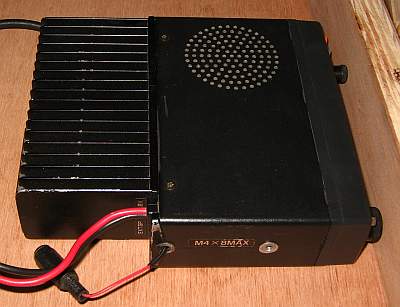 So
I decided to do an evil deed, unthinkable to most hams, cruel,
sanguinary, and awfully gory: I would prune my existing TM-241 down to
size, so that it would fit the available space!
So
I decided to do an evil deed, unthinkable to most hams, cruel,
sanguinary, and awfully gory: I would prune my existing TM-241 down to
size, so that it would fit the available space!
After lots of measuring, I determined the exact amount of heat
sink that had to be cut off, so that the knobs of the radio would end
up recessed just enough in the ashtray bay to allow placing a
cover on it. Here you can see my poor radio, knobs against a board,
with a line scratched into its heatsink. Note that the fins of the
right third need to be cut a little shorter than the others, because
there is an obstruction in the ashtray bay on that side.
The poor radio was shivering from fear!
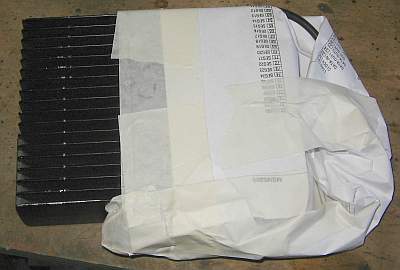 All
surgery requires some draping to keep the dirt out, right? I
wrapped my radio in old paper (an IC pinout, and a schematic
diagram), taped on with masking tape. This is to keep the aluminium
sawdust from flying into the radio through every little opening it
can find!
All
surgery requires some draping to keep the dirt out, right? I
wrapped my radio in old paper (an IC pinout, and a schematic
diagram), taped on with masking tape. This is to keep the aluminium
sawdust from flying into the radio through every little opening it
can find!
The tape also holds the cables out of harm's way.
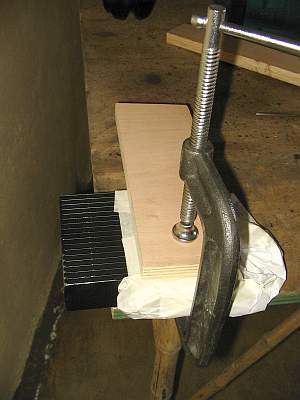 By
this time, my radio was seriously considering the possibility of
running away, to escape surgery! So I had to restrain it on the
operating table.
By
this time, my radio was seriously considering the possibility of
running away, to escape surgery! So I had to restrain it on the
operating table.
I don't have any anesthesia for radios, and this increases the need for
very good restraining, or the radio WILL run away in the midst of
surgery! It's a little like pulling a tooth in the middle ages.
 This
is the most delicate surgical instrument I found, that would do the
task You surely know, an amputation without anesthesia hurts less if
done quickly, so a powerful saw with a sharp blade is best.
This
is the most delicate surgical instrument I found, that would do the
task You surely know, an amputation without anesthesia hurts less if
done quickly, so a powerful saw with a sharp blade is best.
I will spare you the gory scene of aluminium dust flying all around the
workshop, and the poor little radio shrieking in desperation!
 The
rear 40% of the heatsink came off in one piece. Then I cut off small
slices of the rightmost several fins. I then rescued the poor little
radio, even smaller now than ever, from its surgical draping. It was
still shocked, but soon recovered.
The
rear 40% of the heatsink came off in one piece. Then I cut off small
slices of the rightmost several fins. I then rescued the poor little
radio, even smaller now than ever, from its surgical draping. It was
still shocked, but soon recovered.
This is a 50 watt radio, and the output module is only about 50%
efficient. That means at least 50 watts of heat is put into the little
heatsink stub that remains, during full power transmission. The
original specs state a maximum TX duty cycle of only 25%. It's
clear that after cutting off half of the heatsink, this has to be
degraded further.
On the other hand, at most times it's fine to use low power. At 5 watts
output, the module is awfully inefficient, but still the dissipation
decreases to about 15 watts. So I think that the radio is still safe to
use for pretty long transmissions and high duty cycle at 5 watts
output, but when using 50 watts the duty cycle will have to be kept
VERY low. Other than that, there should be no effect from the heatsink
amputation.
Many if not all TM-241 transceivers were delivered with the
output module mounted dry, without heat conductive compound! I
added a thin layer of this stuff, which is very easy to do, and that
should slightly attenuate the effects of the loss of heatsink area.
What counts, after all, is the total thermal resistance from the power
transistor junctions to the air.
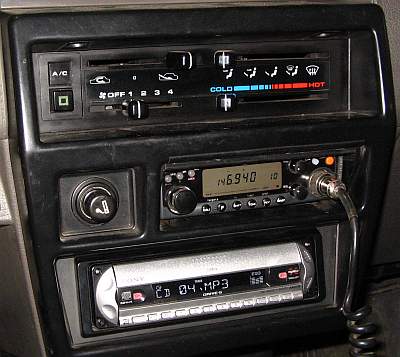
The radio has been reinstalled in its rightful place, well recessed in
the ashtray bay of my car. It's easy to reach, easy to see, and well
protected. The area where the radio sits also houses the air
conditioner, so it is very cool there whenever the air conditioner is
running. That should help in keeping the radio safe even with that
small remaining heatsink stub.
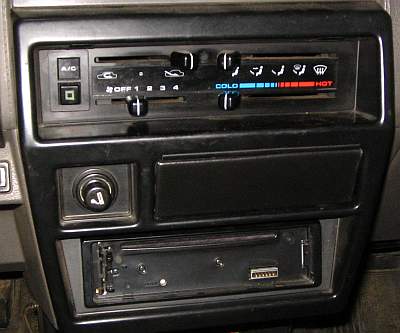 When
I need to park the car in dangerous places, which include basically any
place where people freely stroll past, the cover is placed over
the TM-241, and the front panel of the music radio is removed and taken
away. That should help quite a bit in making thieves move on to the
next car.
When
I need to park the car in dangerous places, which include basically any
place where people freely stroll past, the cover is placed over
the TM-241, and the front panel of the music radio is removed and taken
away. That should help quite a bit in making thieves move on to the
next car.
I can imagine that many hams would never ever do something as cruel as
this to their radios. These are the same kind of people who will never
ever drill a hole in the car's roof to mount an antenna! But I believe
that technical goods are here to serve us, and we do not have any duty
to preserve them in pristine, like-new condition. We have the right to
adapt them to out needs. Let's face it: My TM-241 was almost worthless
anyway. It's an old radio. You can buy a brand new FT-1900 for 150
dollars in many places of the world, or for 240 dollars here in Chile,
where everything is more expensive than elsewhere. That radio has
slightly better overall performance, 10 times as many memories,
and many more features and functions than the old TM-241. So, a
perfect, like-new TM-241 might be worth 60 dollars, perhaps. But mine
had suffered several failures, which I fixed one after another. It's
not a like-new radio. Also I replaced the power connector by a
different type, to avoid needing different connectors for every radio.
And I made several internal modifications to it, to suit my needs. So,
it might have been worth 10 dollars... and I don't think it lost much
of that fabulous value by amputating half of its heatsink! But to me
that gory amputation means getting back on VHF mobile, without the
constant fear that a car window will be destroyed to steal the
radio.
And if a thief happened to steal my pruned TM-241, I would be eager to see how he manages to sell it!
Back to homo ludens radiactivus.
 Many
years ago I purchased a Kenwood TM-241 VHF mobile transceiver. The
reason why I chose this specific model is a simple one: My car came
with an ashtray built into the dashboard! I mean, what good is an
ashtray to a non-smoking driver who is also a radio amateur? Certainly
that space would be better used for a radio than for a silly ashtray!
And the TM-241 has just the right width and height to fill the gaping
hole left after removing the ashtray.
Many
years ago I purchased a Kenwood TM-241 VHF mobile transceiver. The
reason why I chose this specific model is a simple one: My car came
with an ashtray built into the dashboard! I mean, what good is an
ashtray to a non-smoking driver who is also a radio amateur? Certainly
that space would be better used for a radio than for a silly ashtray!
And the TM-241 has just the right width and height to fill the gaping
hole left after removing the ashtray. So
I decided to do an evil deed, unthinkable to most hams, cruel,
sanguinary, and awfully gory: I would prune my existing TM-241 down to
size, so that it would fit the available space!
So
I decided to do an evil deed, unthinkable to most hams, cruel,
sanguinary, and awfully gory: I would prune my existing TM-241 down to
size, so that it would fit the available space! All
surgery requires some draping to keep the dirt out, right? I
wrapped my radio in old paper (an IC pinout, and a schematic
diagram), taped on with masking tape. This is to keep the aluminium
sawdust from flying into the radio through every little opening it
can find!
All
surgery requires some draping to keep the dirt out, right? I
wrapped my radio in old paper (an IC pinout, and a schematic
diagram), taped on with masking tape. This is to keep the aluminium
sawdust from flying into the radio through every little opening it
can find! By
this time, my radio was seriously considering the possibility of
running away, to escape surgery! So I had to restrain it on the
operating table.
By
this time, my radio was seriously considering the possibility of
running away, to escape surgery! So I had to restrain it on the
operating table. This
is the most delicate surgical instrument I found, that would do the
task You surely know, an amputation without anesthesia hurts less if
done quickly, so a powerful saw with a sharp blade is best.
This
is the most delicate surgical instrument I found, that would do the
task You surely know, an amputation without anesthesia hurts less if
done quickly, so a powerful saw with a sharp blade is best. The
rear 40% of the heatsink came off in one piece. Then I cut off small
slices of the rightmost several fins. I then rescued the poor little
radio, even smaller now than ever, from its surgical draping. It was
still shocked, but soon recovered.
The
rear 40% of the heatsink came off in one piece. Then I cut off small
slices of the rightmost several fins. I then rescued the poor little
radio, even smaller now than ever, from its surgical draping. It was
still shocked, but soon recovered.
 When
I need to park the car in dangerous places, which include basically any
place where people freely stroll past, the cover is placed over
the TM-241, and the front panel of the music radio is removed and taken
away. That should help quite a bit in making thieves move on to the
next car.
When
I need to park the car in dangerous places, which include basically any
place where people freely stroll past, the cover is placed over
the TM-241, and the front panel of the music radio is removed and taken
away. That should help quite a bit in making thieves move on to the
next car.